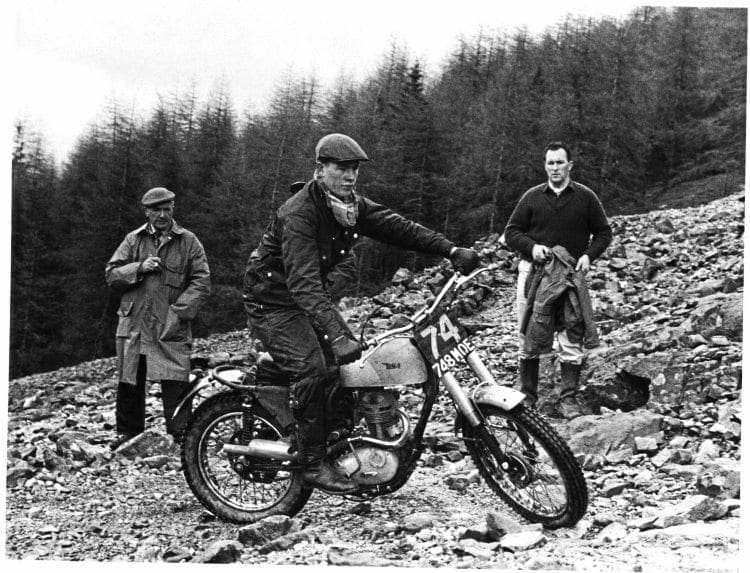From our 2016 archive
In 1966, while England’s footballers prepared to write their names in World Cup history, a young Yorkshire lad was putting his on the JR Alexander Trophy.
Words: Tim Britton Pic: Tim Britton and Morton’s archive
“Does it feel 50 years ago?” I asked Alan Lampkin as he posed self-consciously with his 1966 Scottish Six Days Trial-winning C15 BSA. “No it doesn’t,” he said, “but I suppose it must be.” By finishing four marks ahead of Sammy Miller in the 1966 event Alan became the second Lampkin to win the JR Alexander Trophy. His similarly mounted elder brother Arthur won three years previously and younger brother Martin would take his first win 10 years later. By all accounts it was a tough old week even by SSDT standards, with weather and clerical error playing their part in the eventual outcome of the trial.

As we chatted about the trial and his C15, Alan told me his brothers reckon he’d won the Scottish FIVE Days Trial, as for that year only the trial started in Edinburgh as usual but finished on Saturday in Fort William, denying riders the not always enjoyable scenic 130-odd mile ride south. “It was a logistical nightmare,” Alan says, “pick-up trucks, vans, cars and trailers were all at Edinburgh and had to be fetched somehow.” But, at the start of the week all that was ahead of the 193 riders, of which Alan was expected to do well, but all eyes were on other riders. According to Bob Currie in the MotorCycle Alan had joined the giants of the sport with this win – I guess he’ll be blushing at that description but that’s what was written in 1966 – it came hot on the heels of his Bemrose National win and showed him to be a force to be reckoned with.
As ever with those of us who write about the sport we have a slight advantage over our interviewees, as it’s easy to pop into the archive at work, spend some time reading through the reports of the day and be able to jog memories. For instance for the SSDT report there are daily leaderboards with the top 12-15 riders listed, so from that it was easy to see that six riders, Sid included, were clean on day one, with four riders on one mark and another two on two. However, at the end of day two Alan was on his own at the top of the leaderboard, a mark clear of arch-rivals Miller and Mick Andrews. He maintained this position for the rest of the week but the gap between him and the second-placed man fluctuated from five marks at one point and then back down to two as Andrews battled for his first win too.
In a seemingly unflappable display of riding Alan kept his cool all week and despite a hiccup on Friday, when briefly he lost the lead to Miller, he pulled it all together and finished four marks ahead of the Bultaco ace and the name ‘ARC Lampkin’ was expected to be inscribed on the Alexander Trophy as the final day, Saturday, was a leisurely one-and-a-half miles to Town Hall Bray for one section then the stop/start and brake tests before the final machine examination. “Now then,” I chucked into the conversation, “there’s a lovely photo of you at the finish with actress Fenella Fielding sitting on your BSA.” He said: “Fenella was the guest at a luncheon arranged by one of the petrol companies, Shell or BP I think. How on earth I managed to make that dinner was a mystery, as we’d been out the night before and well, it were a reet good Yorkshire do,” he explains. You can tell from the picture that he was not quite a picture of health.
There was a bit of disgruntlement over time on Wednesday’s run, when a Swedish rider suggested either the mileage on the route card or the time clock was incorrect for the last stage of the run – 31 miles from Glen Shira to Fort William. This was backed up by a larger number of riders than could be expected running late. The organisers realised the published mileage was short and allowed a few more minutes, which swapped a few positions around, though not Alan’s. The discussion went on into the night with those who had made it on time unhappy with those that hadn’t had their time penalties removed. A total of 45 riders signed a protest letter and it was handed to the organisers with the required £1 protest fee… they threw it out and stated 45 letters and 45 £1 notes was the way forward. This was done and the protest was handed in, though it was eventually
over-ruled and the results stood but in a gesture to the riders, if not an admission that they had a point, the organisers gave the protest fee back.
BSA C15 748 MOE
Alan’s works C15 was registered on March 26, 1964 in Birmingham and issued to him shortly after, well in time for the Scottish that year and also for his first National win – the Travers Trophy. Really the production four stroke trials bike had had its day at BSA by the mid-Sixties, the two strokes were in the ascendency and even comp shop boss Brian Martin was working on the Bantam with a view to making it into a proper trials bike.
The C15 had been introduced in the late Fifties and the first batch contained enough bikes to be drip fed into the dealers through to 1962. A second batch with the scrambler’s new all-welded type of frame was produced for 1963 and sadly it looked less and less like a trials bike and more like a trail machine. The works bikes would resemble this production version while there was a production version to sell but it would have subtle differences though. Alan’s bike was originally a distributor type motor but was changed to a side-points bottom end type for the SSDT. Effectively this is the BSA Victor scrambler engine and also the basis for the WDB40. It was known to be a tough, reliable motor which could handle anything a trial could throw at it, as several other works men had been using just such a bottom end since 1963. Strangely though, even for the works bikes the barrel remained cast iron when a much lighter one could easily have been cast. Alan reckoned the engine wouldn’t be all that trick really. “There might be a scrambles cam in there,” he muses, “but nothing really special elsewhere. It will have been really well put together and even the energy transfer ignition worked quite well.”
Though the production bike had a welded frame it was a much heavier lump than the works Victor scrambler version the Lampkins were issued with. This Victor type frame would be of a lighter steel than the production one, have slightly different dimensions and also house the oil in the frame rather than have a separate oil tank. Instantly the bike is going to be lighter. Thanks to the dimensions of the frame it was now possible for the works men at least to use a 21in front wheel instead of the production bike’s 20in. The smaller rim was fitted according to the publicity department because it was a ‘good general purpose size which floats over rocks more easily’ but in actual fact it was fitted because the larger size hit the frame downtube when used with the longer travel forks of the competition machine. A quick fix in the comp department was to restrict fork movement by 1/2in, something the production and sales department were not prepared to do for the public. The later bikes also inherited this size as it seems the factory had a few too many 20in wheels in stock. The problem was reasonably easily solved by making new fork yokes which tipped the top of the forks out a little, eased the clearance and allowed the full 5in of fork movement to work with the larger rim. Having to guarantee motorcycles for the public and with little control over who would be riding them or their ability, BSA fitted the production bikes with large diameter brakes. Works riders, however, were deemed capable of coping with the much lighter Bantam hubs, which knocked a few pounds off the all up weight of the bike. Finishing off the chassis would be a handsome Victor alloy tank, most likely finished in yellow with polished panels.
Looking at the bike Alan pointed out it wouldn’t be too hard a thing to replicate, even in the Sixties. “Everything is BSA and would have been available in BSA spares department catalogues – all you’d need would be a friendly dealer prepared to order everything for you and you could build a works replica.” He said the fork yokes might have been a bit tricky to get but making a set wouldn’t have been a problem. “I see all these bikes these days with alloy slab yokes which we could have done in the workshop here if we’d been allowed to modify the bike back then. Other than that and maybe not knowing what the factory had done to the internals, it wouldn’t have been a difficult job to get what we were riding.”
Life after Lampkin
The three Lampkin brothers all had works BSA C15s. Arthur has his at his son John’s Beta importership and we featured that one in CDB 33, and as we were photographing that one Alan learnt his bike had turned up too. After he’d parted with it the C15 had travelled about a bit, gone through six owners, two of them in Scotland, before ending up in Nottinghamshire and looking quite sorry for itself.
Back at Lampkin HQ the bike was cleaned up, Alan flushed the oil through the frame and engine to make sure it was clean, cleaned out the petrol tank and carburettor, sorted the ignition so there was a spark, tipped in fresh petrol, leaned on the kick-start… and the BSA burst into life. “It didn’t even smoke,” he grins. It was obvious Alan was delighted to have his old works machine back and he added that the whereabouts of younger brother Martin’s C15 is also known, which would make for an interesting team entry in the pre65… three genuine works bikes.
So preparations are underway for the bike to be right for Scotland and that’s why our photos show it as found rather than as it will be. The eagle-eyed will also notice from some of the archive photos with this feature the early version of 748 MOE is a lot less shiny. “On one of its trips back to the factory for a fettling session it was decided to chrome as much as possible so the frame, swingarm, fork yokes and fork sliders joined the exhaust system, handlebars and kick-start in the plating bath. “It looked really nice when it came back and we’ll make it look that way again,” says Alan. Hopefully, this will be done for the Classic Dirt Bike Show at Telford on February 20/21 this year when we hope to have the bike on show as part of our ‘decades tribute’.




